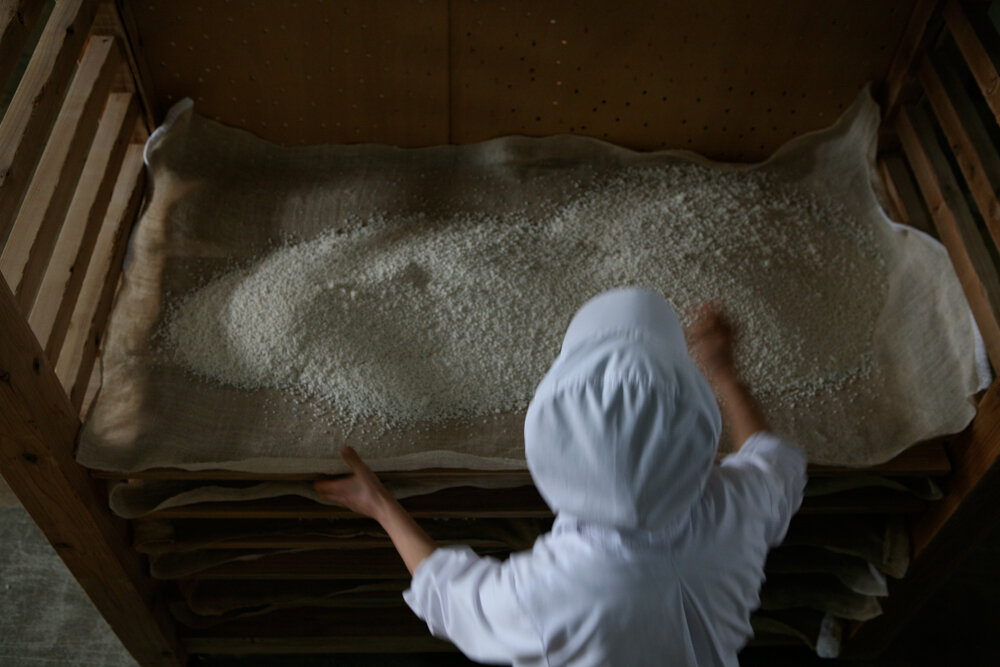
Sake Terms

Common Sake Terms
Amakuchi: Sweet sake
Amami: Sweetness
Arabashiri: First 1/3 of the batch off the press; high quality
Atsukan: Hot sake, implies very hot
Bin Kan: In bottle pasteurization
B.Y.: Brewing Year ie. July ’16 ~ June ’17 = BY ‘16
Choko: Traditional small cup for drinking sake
Chozo: Storage, aging, maturation
Daiginjo: Super premium sake; minimum milling 50% original size
Dewa Sansan: Sake rice variety from Yamagata Prefecture
Fune: Traditional wooden sake press
Fune-shibori: Sake pressed with a “fune”, Traditional wooden box
Fushimi: A ward in Kyoto, second largest brewing center in Japan
Futsu-shu: “Regular” sake; non-premium, about 74% of the market
Genshu: Undiluted sake; often higher in alcohol content
Ginginja: Sake rice variety from Iwate Prefecture
Ginjo: Premium - super premium sake; four categories = 7% mkt
Ginpu: Rice variety from Hokkaido Prefecture
Gohyakumangoku: Important rice variety from Niigata
Gomi: 5 flavors assess sake: Sweet, Dry, Acid, Bitter, Astringent
Hanmai: Eating rice…non-sake rice
Hattan Nishiki: Sake rice variety from Hiroshima
Hatsu-zoe: The first of the three additions of rice, koji, water
Hi-ire: Pasteurization
Honjozo-shu: Lowest level of prem. sake; min. milling 30%; alc. Added
Ishobin: 1.8Ltr Bottle
Jizake: vague term referring to local sake, small local brewers
Joso: Pressing sake from the lees after fermentation
Junmai: Made with no added alcohol: only rice, water, koji
Junmai Ginjo: Prem. sake; min. milling 60% original size; no added alc.
Kakemai: The steamed riced added to sake batch; no koji mold
Kame no O: An heirloom strain of sake rice grown mostly in N. Japan
Kanzake: Warm sake
Karakuchi: Dry sake
Karami: Dryness of flavor
Kasu: Lees or dregs that remain after mash has been pressed
Kasui: Adding water to genshu (undiluted) to lower alc. Level
Kikijoko: Traditional white porcelain tasting cups w blue rings
Kimoto: Original pole method of preparing moto w lactic bacteria
Kobo: Yeast
Koji: Rice onto which koji mold (aspergillus oryzae) is grown
Koji-kin: Aspergillus Oryzae; mold which converts starch to sugar
Koshu: Old sake either deliberately or accidentally aged
Koji Muro: The room in a brewery where the koji is produced
Kura: A sake brewery
Masu: A wooden box traditionally used fro measuring rice
Merir Kobo: A yeast commonly used for highly aromatic sake
Miyama Nishiki: Sake rice grown in Nagano and northern Japan
Miyamizu: Famous water from Nada; great brewing characteristic
Moromi: Fermenting mash
Moto: Yeast starter, synonomous with Shubo
Muroka: Unfiltered (no charcoal), clear but richer bodyNa
Nada: One of the cities of Kobe; produces 1/3 of all sake
Nakadori: Middle 1/3 of pressing; most prized portion of the batch
Nakazoe: 2nd addition of three additions of rice, water, koji to batch
Namachozo: Sake stored unpasteurized before bottling, then Pasteur.
Namazake: Unpasteurized sake; wilder more youthful zing
Nigori: Cloudy sake; ie sake with some remaining lees
Nihon-shu: Word for sake used to differentiate from it other alc bev.
Nihonshu-do: A number that indicates the relative dryness or sweetness
Nuru-kan: Sake that is slightly warmed but not hot
Sakagura: A sake brewery; a kura
Sakamai: Sake rice
Sake: In Japanese a term that refers to all alcoholic beverages
Sandan Shikomi: A three stage addition process used in sake brewing
Sando: Measure of sake acidity level
Seimai Buai: Number indicating % of rice remaining after milling ie 60
Seishu: Legal name for Sake
Shibori: Pressing the moromi through a mesh produces clear sake
Shiboritate: Just pressed sake. Very young sake
Shikomi: Making a batch of sake: assembling the ingredients
Shimpaku: White pearl center of sakemai; indicates starch location
Shizuku: Process of drip-pressing the sake; best and most delicate
Shubo: The yeast starter; synonomous with Moto
Sokujo moto: Fast yeast starter; not Kimoto or Yamahai; 99% of all sake
Tamazakae: Rice variety indigenous to Shiga and Tottori Prefectures
Taruzake: Sake stored in cedar or wooden vats to absorb flavor
Toji: Master brewer
Tokubetsu: Indicates “Special”…ie Tok. Junmai; Tok. Honjozo
Umami: A flavor component described as Richness, Yumminess
Wataribune: An heirloom rice grown near Pacific coast near Tokyo
Yabuta: Brand name of popular sake press; accordian-like
Yamada Nishiki: Important sake rice indigenous to Hyogo Prefecture
Yamahai: yeast starter involving natural lactic bacteria, wild gamey
